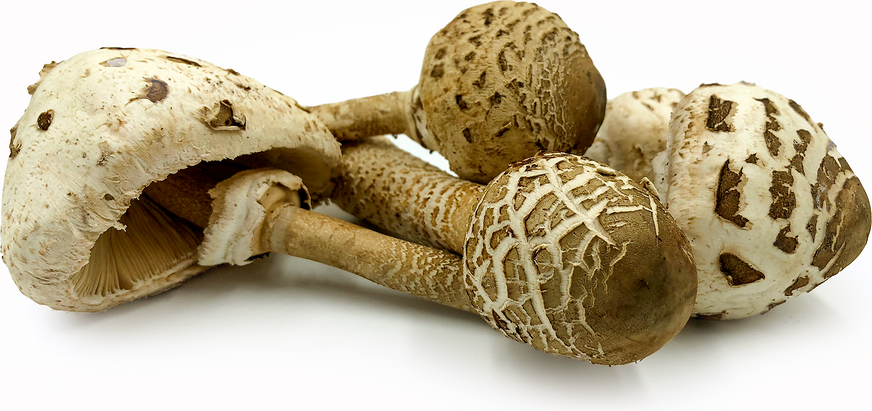


Parasol Mushrooms
Estimated Inventory, lb : 0
Description/Taste
Parasol mushrooms are medium to large in size with caps and stems that can reach up to forty centimeters in height and diameter. When young, the pale brown caps are egg-shaped and rounded with a small dark brown nob at the top. As they mature, they open into an umbrella shape, eventually flattening out, and the dark brown nob breaks into flaky scales. The average Parasol cap ranges from 10-25 centimeters in diameter and has white, soft, and slightly spongy flesh when sliced. Underneath the cap, there are free, crowded, white gills and the ivory colored stem is fibrous with a snakeskin-like pattern of dark brown flakes. There is also a partial veil that breaks and becomes a movable ring on the stem as the mushroom matures. When cooked, Parasol mushrooms are tender and are known for their rich umami flavor and their nutty, sweet aroma that some say smells like maple syrup. This flavor becomes more intense as the mushroom ages and more pungent if the mushroom is dried.
Seasons/Availability
Parasol mushrooms are available in the summer to early winter.
Current Facts
Parasol mushrooms, botanically classified as Macrolepiota procera, are a wild, edible North American and European species that belong to the Agaricaceae family. Also known as the Snake’s Hat mushroom and the Snake’s Sponge, Parasol mushrooms grow individually or in fairy rings in temperate regions in pastures, trail edges, grassy seaside cliffs, lawns, and in open forests. Parasol mushrooms are considered gourmet mushrooms in Europe, prized for their large size and seasonality, and are highly sought after in the wild as they cannot be cultivated on a large scale.
Nutritional Value
Parasol mushrooms contain vitamin D, iron, zinc, copper, selenium, fiber, amino acids, and also contain some antioxidant and antimicrobial properties.
Applications
Parasol mushrooms must be cooked before consumption and are best suited for applications such as sautéing, frying, boiling, and roasting. They can be chopped and used in stews or soups, sliced and cooked in omelets, blended into sauces, mixed into stir-fries, baked into pies, stuffed with vegetables or meat, and fried to make tempura. In eastern Europe, Parasol mushrooms are also commonly dipped in egg, fried with breadcrumbs, and served with bread to make a vegetarian cutlet. Parasol mushrooms pair well with ground pork or beef, poultry, oregano, paprika, parsley, rosemary, garlic, onion, shallots, potatoes, cucumber, pickles, cheeses, and lemon juice. They will keep up to five days when stored whole and unwashed in a paper bag in the refrigerator. It is important to note that there are some Parasol lookalikes that are toxic and deadly. Extreme caution should be taken when foraging, along with research and checks by experts before consuming a mushroom from the wild.
Ethnic/Cultural Info
Parasol mushrooms are prominent throughout European folklore. In Scotland, legend has it that fairies sit atop Parasol mushrooms and use them as dinner tables. In Wales, fairies supposedly use the Parasol mushroom as umbrellas. Parasol mushrooms have also been commonly featured in the artwork of Europe, and in 1995, a stamp in Azerbaijan featured Parasol mushrooms. In addition to folklore, Parasol mushrooms grow in some Himalayan regions where it is common for cattle herders to collect wild Parasols for food.
Geography/History
Parasol mushrooms are native to Europe and the United States. First recorded in 1772 and placed under its current genus in 1948, Parasol mushrooms can be found at farmers markets and in the wild in southern England, Ireland, northwestern Himalayan regions of Garhwal and Himachal Pradesh, and the United States.
Recipe Ideas
Recipes that include Parasol Mushrooms. One
Podcast




